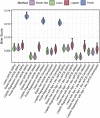GenoRisk: A polygenic risk score for Alzheimer's disease
- PMID: 34621978
- PMCID: PMC8485054
- DOI: 10.1002/trc2.12211
GenoRisk: A polygenic risk score for Alzheimer's disease
Abstract
Introduction: Recent clinical trials are considering inclusion of more than just apolipoprotein E (APOE) ε4 genotype as a way of reducing variability in analysis of outcomes.
Methods: Case-control data were used to compare the capacity of age, sex, and 58 Alzheimer's disease (AD)-associated single nucleotide polymorphisms (SNPs) to predict AD status using several statistical models. Model performance was assessed with Brier scores and tenfold cross-validation. Genotype and sex × age estimates from the best performing model were combined with age and intercept estimates from the general population to develop a personalized genetic risk score, termed age, and sex-adjusted GenoRisk.
Results: The elastic net model that included age, age x sex interaction, allelic APOE terms, and 29 additional SNPs performed the best. This model explained an additional 19% of the heritable risk compared to APOE genotype alone and achieved an area under the curve of 0.747.
Discussion: GenoRisk could improve the risk assessment of individuals identified for prevention studies.
Keywords: Alzheimer's disease heritability; Alzheimer's disease prevention studies; cross‐validation; genetic risk; model validation; polygenic risk score; regression; risk models.
© 2021 The Authors. Alzheimer's & Dementia: Diagnosis, Assessment & Disease Monitoring published by Wiley Periodicals, LLC on behalf of Alzheimer's Association.
Conflict of interest statement
Suzanne Hendrix, as the owner of Pentara, received support from Affirmative Diagnostics for the manuscript and received contract work from AC Immmune, Acumen, ADCS, ADDF, Affirmativ Dignpostics, Alector, Alkahest, Allergan, Alzheon, Amylyx, Apodemus, Athira, Avanir, Banner, Biogen, Biohaven, Cadent, Capricor, Cerecin, Cognito, Cognoptix, Cortexyme, Elusis, Green Valley, Grifols, Ionis, Janssen, Kyowa‐Kirin, Lexeo, LuMind, Lundbeck, NCRI, Nilvad, NovoNordisk, Nutricia, Photopharmics, PTCBio, Regenera, Retrotope, Richard Isaacson, Samus, Soleno, Spaulding, Suven, Takeda, Telocyte, Tetra Discovery, Toyama, United Neuroscience, Vaccinex, Vacinity, vTv Therapeutics, and WGU. Suzanne Hendrix has also received royalties from Wiley in the last 36 months; received honoraria for lectures, presentations, etc. from Biogen; received support in the last 36 months from Grifols and Nutricia for presentations and conference attendance; claims one patent pending Brown BL, Hedges DW, Hendrix SB (2014) Extracting A periodic Components from a Time Series Wave Data Set—Patent Pending with a filing date of October 16, 2013, Application Number PCT/US2013/065327; and participated in Alzheon, Cortexyme, and Janssen DSMB or Advisory Board in the last 36 months. Samuel P. Dickson received support from Pentara, which in turn received support from Affirmativ Diagnostics for the manuscript. S. B. Booth received support from Affirmative Diagnostics for the manuscript; received travel support from her employer for work events; ADX provides profit sharing incentives with additional salary which were broadly applied to any work performed for the company (including manuscript generation). J. S. K. Kauwe received support for the manuscript from Brigham Young university and has received honoraria from UH Hilo. B. L. Brown received support through the following grants: Measuring the Interactive Effects of COVID‐19 and Latent Infections on Patterns of cognitive Timing: A Middle‐Aged to Elderly Sample from the Utah Valley Community. Translational Medicine Award from the BYU Simmons Research Endowment ($31,300). This is an intramural grant from a research endowment within our university to my departmental research fund. Brown also claims one patent pending Brown BL, Hedges DW, Hendrix SB (2014) Extracting A periodic Components from a Time Series Wave Data Set—Patent Pending with a filing date of October 16, 2013, Application Number PCT/US2013/065327. Data used in this manuscript is publically available. Participant consent is not needed, and was obtained from investigators who ran each study. M. L. Hardy has received paid consulting fees to the LLC solely owned by ML Hardy from ixLayer, NW Pathology & Labs, Mt. Baker Imaging, PlumCare, ADx Healthcare, Architectural Elements; received travel support from her employer for work events; and was the past Volunteer Secretary for the Lets Pool Together and Hope Philantropies non‐profit boards. P. G. Ridge had received honoraria from University of Kansas Alzheimer's Disease Center for a seminar presentation. R. R. Fortna is a board member of Northwest Pathology and ADx Healthcare and is co‐owner and holds stock for ADx healthcare. J. Nicodemus Johnson has nothing to disclose.
Figures





References
Grants and funding
LinkOut - more resources
Full Text Sources
Miscellaneous
